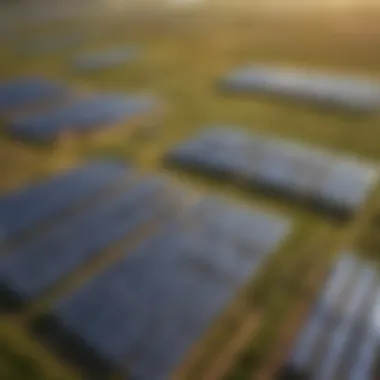Top Strategies for Smart Green Energy Investments


Intro
Investing in green energy has become a key focus for many looking to align their financial pursuits with environmental ideals. With a world increasingly aware of the impacts of climate change, this topic is more relevant than ever. As funding and support for sustainable initiatives grows, investors are presented with a myriad of opportunities. From solar farms to wind turbines, the possibilities are expansive, yet the choices can sometimes seem overwhelming.
This piece lays out elementary principles and approaches to investing effectively in renewable energy. We’ll touch upon various avenues, ranging from investing in established renewable energy stocks to exploring the potential of green bonds and venture capitalists. Additionally, we will dissect risks involved and examine emerging market trends, offering readers a practical understanding of where to put their money right now in the evolving arena of green energy.
As we navigate this territory, it will be essential to evaluate potential impacts not just on personal portfolios but also on broader sustainability goals. This guide aims to be a well-rounded resource for students, researchers, educators, and professionals eager to make informed decisions in a sector ripe with promise.
Green energy investments not only signify astute financial choices for the future but also contribute to a more sustainable planet. Let’s delve into the foundations of this burgeoning field and discover the strategies that could lead to both personal financial gain and societal benefit.
Understanding Green Energy
Understanding green energy is crucial in today’s rapidly changing environment. As we all become more aware of the effects of climate change and the need for sustainable solutions, knowledge in this field can be a game-changer. Investing in green energy is not just about financial gain; it’s about investing in a future that's more sustainable and eco-friendly for generations to come.
Definition and Importance
Green energy refers to the energy that comes from renewable sources, like sunlight, wind, rain, tides, waves, and geothermal heat. Unlike conventional energy sources, such as fossil fuels, green energy is vital for reducing greenhouse gas emissions. It plays a significant role in mitigating the effects of climate change and ensuring a healthier planet. The importance of understanding this concept lies in its potential to align investment strategies with environmental and social governance (ESG) principles.
Getting a grip on what green energy entails helps investors make smarter choices that could also have a positive impact on society at large. The transition to renewable energy sources is not merely a trend; it signifies a shift in economic priorities that could influence market performance and growth in various sectors.
Current Trends in Green Energy
The current trends in the green energy landscape present an exciting picture. There’s a noticeable uptick in investments directed towards renewable energy technologies. Solar, wind, and hydropower are not just buzzwords anymore; they are the pillars of new infrastructure projects. This surge is fueled by increasing public awareness and governmental policies supporting sustainability.
A few things to keep an eye on:
- Technological Advances: Breakthroughs in battery storage and efficiency are expected to drive down costs, making alternative energy sources more competitive with fossil fuels.
- Decentralization: More people are turning to community-based energy solutions, like solar panels on residential roofs, contributing to localized green energy production.
- Corporate Responsibility: Big companies are making commitments to reduce their carbon footprints and invest in renewable energy, influencing market dynamics.
The demand for clean energy is at an all-time high, and staying attuned to these trends can provide valuable insights into where the market is heading.
Global Initiatives and Policies
Various global initiatives and policies play a significant role in shaping the green energy sector. The Paris Agreement, for instance, has urged countries to commit to reducing carbon emissions and transition to cleaner energy sources. Such international agreements compel nations to create supportive regulatory environments for renewable energy investments.
Governments are also fostering this change with incentives:
- Subsidies and Grants: Many countries provide financial support for renewable energy projects, making them more appealing to investors.
- Tax Breaks: Tax incentives for those investing in green technologies can significantly enhance the return on investment.
- Renewable Energy Standards: Mandates requiring utilities to secure a specific portion of their energy from renewable sources encourage businesses to switch.
Through these initiatives, global agencies and local governments pave the way for a more resilient energy future. It's important for investors to stay informed about these policies, as they can significantly influence market viability and opportunities in the green energy sector.
Types of Green Energy Investments
Investing in green energy presents myriad opportunities that cater to a wide range of investors. With sustainability in mind, an influx of capital into this sector not only bolsters the economy but also addresses pressing environmental concerns. By understanding the types of green energy investments available, you can make informed choices tailored to your own financial goals while contributing positively to the planet's future.
Renewable Energy Stocks
Renewable energy stocks represent shares in companies that engage in the production and distribution of energy derived from renewable sources. Investing in this category allows investors to support firms developing solar, wind, hydropower, and biomass technologies. This sector has seen considerable growth due to increased global demand for cleaner energy alternatives.
The benefits are evident: many of these companies not only have a robust growth trajectory but can also provide returns that rival traditional energy stocks. However, it’s imperative to note that investing in renewable energy stocks comes with certain risks, specifically market volatility tied to changes in government policies or technological progress. Investors should follow industry trends closely and analyze individual company's performance.
Green Bonds
Green bonds are fixed-income securities specifically earmarked to raise money for climate and environmental projects. They have become a preferred choice for socially responsible investors. With the green bond market expanding, investors have the opportunity to finance renewable energy projects, energy efficiency upgrades, and other environmentally friendly endeavors.
The allure of green bonds lies in their dual benefits: they typically offer fixed returns alongside the knowledge that their investments contribute to sustainable development. However, investors should scrutinize the issuer’s credibility and ensure transparency about how funds are utilized. As with any financial instrument, the risks associated with green bonds, such as credit risks and interest rate fluctuations, should also be taken into account.


Real Estate for Solar Energy
Investing in real estate that incorporates solar energy systems is an innovative way to tap into the green energy trend. Properties equipped with solar panels not only reduce energy costs but can also increase their market value. Such investments often appeal to eco-conscious tenants or buyers, creating a demand for green living spaces.
When considering this pathway, a detailed analysis of the location and potential solar energy output is essential for maximizing ROI. Additionally, understanding local legislation and potential tax incentives can make a significant difference in the financial success of solar-enabled real estate investments.
Venture Capital in Startups
The venture capital route offers a unique opportunity for investors willing to take on higher risk for potential high rewards by funding innovative startups in the green energy space. Startups that focus on developing cutting-edge technologies, such as energy storage solutions or advancements in clean energy efficiency, can pave the way for transformative changes.
In essence, investing in these emerging companies not only gives you a stake in potentially lucrative ventures but also aids in the acceleration of the green revolution. However, prudent investors should carry out thorough due diligence on the startup's business model, management team, and the scalability of their technology before making financial commitments.
In summary, understanding the diverse landscape of green energy investment opportunities equips investors with the tools needed to make sustainable financial decisions while embracing the transition towards a cleaner energy future.
Evaluating Investment Opportunities
Evaluating investment opportunities in green energy is a critical step in itching over the best paths for sustainable investments. This process isn't just about looking for high returns, but about aligning investments with ethical and environmental standards. The ever-evolving landscape of green energy presents a variety of chances, which requires a thorough understanding of various elements that influence this sector.
As the world shifts toward sustainable practices, grasping the factors behind investment choices becomes increasingly important. Investors need to dig deep into market performance, technological viability, and company ethics to make informed decisions. After all, proper evaluation can lead to not only financial growth but can also foster an active role in combating climate change.
Researching Market Performance
Researching market performance serves as a cornerstone for identifying lucrative investment opportunities. Investors should pay attention to historical trends, market volatility, and economic factors. While the green energy market might appear promising, it is still subject to fluctuations.
- Historical Trends: One should study previous market reports to identify periods of growth and downturn.
- Current Market Conditions: Keep an eye on oil prices, government incentives, and international agreements that may rally or dampen green energy initiatives.
- Competitor Analysis: Look at leading companies in the sector and analyze their stock movements and innovations.
Understanding market performance can help investors gauge where the wind is blowing and plan their strategy accordingly.
Assessing Technological Viability
It's crucial to assess the technological feasibility of the projects being considered. If a new technology isn't reliable or scalable, the investment could be more risky than beneficial.
- Research and Development: Investigate how much companies invest in innovative technologies. A strong R&D pipeline generally indicates a commitment to growth and sustainability.
- Product Performance: Examine products or services offered by companies, noting efficiency ratings and customer satisfaction.
- Partnerships and Collaborations: Strong technological partnerships are often a positive sign of a company's capacity and the future of its products.
Technological assessment isn't just important for the present; it can also hint at future advancements that might change the landscape quickly.
Understanding Company Practices
To be a truly responsible investor, one must scrutinize the practices of companies from an ethical standpoint. Sustainable practices often dictate a company's long-term viability in green energy.
- ESG Criteria (Environmental, Social, and Governance): Look for transparency in a company's operations. Do they provide clarity about their environmental impact?
- Corporate Governance: Good practices can often be reflected in a company’s governance structure and management’s commitment to sustainability.
- Stakeholder Engagement: Companies that maintain active dialogue with communities and investors are usually well-positioned. Engagement reflects a company's willingness to adapt and grow based on feedback.
Understanding a company's commitment to sustainability and ethical practices provides insight into its long-term health and alignment with green energy initiatives.
"A well-informed investor always pays attention not just to profits, but to the broader impact of their investments."
In sum, evaluating investment opportunities in green energy involves a blend of market research, technology assessment, and ethical scrutiny. This multifaceted approach will provide a more rounded perspective, enabling investors to navigate the complexities of the green energy landscape effectively.
Risks and Challenges in Green Energy Investment
Investing in green energy, while promising, is not without its pitfalls. Understanding the risks and challenges in this sector is crucial for making informed decisions. Investors should weigh the potential returns against the backdrop of these challenges, as they can significantly impact investment outcomes. The importance of this topic rests on the fact that identifying risks not only prepares investors for market fluctuations but also aids in devising strategies that align with long-term sustainability goals.
Market Volatility
One of the most salient risks in green energy investment is market volatility. Prices in this sector can shift dramatically due to a variety of factors including changes in government policy, technological advancements, and fluctuating demand for energy. For instance, the price of solar panels may drop with advancements in technology, but such fluctuations can leave investors scrambling to determine the right time to buy or sell.


Understanding the market trends is essential. Here’s what to consider when evaluating volatility:
- Emotional Investing: It’s easy to get swept up in market hype. Practicing restraint and doing thorough research helps counteract emotional decision-making.
- Diversification: By spreading investments across various green technologies, investors can mitigate risk. Investing in solar, wind, and bioenergy provides a buffer against losses in any single area.
- Monitoring Federal Policies: Regulations and incentives can change, impacting market performance. Staying updated with policies can offer insights into potential shifts.
"Investment in green energy should be seen as a marathon, not a sprint. Patience is key to navigating market waves."
Regulatory Changes
The regulatory environment surrounding green energy is both a burden and a boon. On one hand, supportive legislation can foster growth; on the other hand, regulatory changes can create uncertainty.
Investors must navigate:
- Policy Stability: Frequent changes can disrupt projections. If a government suddenly reduces subsidies for wind energy projects, investments can falter.
- Compliance Costs: New regulations may necessitate additional spending on compliance, impacting profitability.
- Incentives Risks: Tax incentives vary widely by region, and shifts can lead to swings in project viability.
Those keeping a close watch on regulatory frameworks are better positioned to adapt to changes swiftly, increasing their chances for success in this evolving landscape.
Technological Risks
Innovation drives the green energy sector. However, rapid progress comes with its own set of risks. Technology can rapidly become obsolete or fail to perform as expected. Being aware of these risks helps in evaluating potential investments.
Key considerations include:
- Investing in Proven vs. Emerging Technologies: Established technologies like solar panels might pose lower risk compared to newer solutions like wave energy converters, which could either skyrocket in value or falter.
- R&D Uncertainty: Startups that focus on next-gen solutions can potentially lead to breakthroughs but come with the risk of bankruptcy if their technology fails.
- Market Adoption Rates: Even the best technology needs consumers willing to adopt it. If a new renewable energy source struggles for acceptance, it could lead to disappointing returns.
Overall, a keen understanding of these risks allows investors to allocate their resources where they might bring the greatest return while fostering environmental sustainability. With the right preparation and knowledge, challenges turn into opportunities in the green energy investment landscape.
Financial Instruments and Strategies
Investing in green energy is not just trendy; it's becoming necessary. In a world grappling with climate change, sustainable investments are growing more critical. Financial instruments and strategies shine here, offering ways for investors to channel funds effectively. Understanding these tools can be the difference between making a profit and betting the farm—figuratively speaking, of course.
It's crucial to recognize the nuances in how we invest. Direct investments offer one route, involving a hands-on approach where investors buy assets like solar farms or wind turbines. Conversely, indirect investments open up opportunities through mutual funds or ETFs that are focused on green technologies. Each method bears its risk and reward, and choosing the right one can align closely with individual financial goals.
Direct Investments vs. Indirect Investments
Direct investments allow you to get your hands dirty, quite literally. Investing in a solar farm means you own a piece of the action and can closely monitor its returns. Here are some pros and cons:
- Pros:
- Cons:
- Direct control over the investment.
- Potentially higher returns.
- Higher initial capital requirement.
- Involvement in operational risks.
On the other hand, indirect investments offer a more hands-off experience. By buying stocks in renewable energy companies or putting cash into sustainable mutual funds, you enjoy a diversified exposure without the operational hassle.
- Pros:
- Cons:
- Easier to manage risk across various sectors.
- Often lower initial investments as compared to direct.
- Less control over individual investments.
- Possible lower returns compared to direct investment opportunities.
Understanding your risk tolerance and investment horizon can help clarify which path suits you.
Tax Incentives and Benefits
Tax incentives are another critical aspect of green energy investments that can significantly impact your bottom line. Governments across the globe are sweetening the deal for eco-friendly initiatives. Tax credits for solar installations, deductions for energy-efficient buildings, and even rebates for electric vehicles can turn the tide in favor of green investments.


For instance, in the United States, the Investment Tax Credit (ITC) allows investors to deduct a percentage of the cost of installing solar energy systems from their federal taxes.
"Incentives like these can amplify your returns, making green investments almost a no-brainer for the financially savvy."
However, it is also essential to keep an eye on the regulatory landscape as these incentives may change based on the political climate.
Impact Investing Frameworks
The concept of impact investing is rapidly becoming the gold standard for responsible investors. This model emphasizes not just financial return but also significant social and environmental benefits. Investment frameworks can vary widely, yet they share common goals: to make investments that address societal challenges while still providing a financial return.
Here’s how to view this:
- Market Rate Investments: Invest in companies that provide solid returns alongside fostering sustainable policies.
- Below-Market Rate Investments: Here, the emphasis is more on social impact than financial gain, such as nonprofit organizations.
Investors can assess their desire for a social impact against the risk and return they are willing to accept, effectively aligning values with financial goals.
Long-Term Outlook for Green Energy Investments
The long-term outlook for green energy investments is increasingly significant as we navigate a world marked by the urgency of climate change and a pressing need for sustainable practices. This section aims to shed light on why understanding the potential growth areas and emerging technologies is crucial for investors. We must consider how shifts in consumer behavior also play a key role in shaping this dynamic landscape.
Potential for Growth
Green energy is not just a growing trend; it’s becoming a cornerstone of modern economies. The International Energy Agency (IEA) forecasts that renewable energy sources could provide up to 80% of global electricity demand by 2050. The rise in awareness about climate issues pushes businesses and consumers alike towards sustainable solutions, making an attractive growth potential for green energy investments.
Investors can look at the following aspects when considering this potential:
- Government Incentives: Numerous countries are reallocating budgets to favor green investments. This can manifest as tax breaks for solar installations or subsidies for electric vehicles.
- Job Creation: The green energy sector has been acclaimed for its job generation capabilities as companies need skilled workers to build and maintain infrastructure, providing a solid foundation for investment.
- Portfolio Diversification: With traditional energy resources facing regulatory pressures and potential decline, green energy investments offer a viable alternative, reducing overall investment risk.
Emerging Technologies
Technological advancement is a pivotal force in driving the green energy movement forward. From solar panels to wind turbines, innovations in efficiency and storage are crucial game changers. Consider these cutting-edge developments:
- Energy Storage Solutions: Companies are racing to improve battery technologies, such as solid-state batteries, which promise longer life and higher efficiency. This leap drives demand for electric vehicles (EVs) and renewable energy systems.
- Smart Grid Technologies: This involves the integration of advanced information and communication technologies in power systems, allowing for better management of electricity distribution, leading to decreased energy waste.
- Hydrogen Fuel Cells: These are set to play a role in decarbonizing various sectors, especially in transportation and industrial processes. Innovations in hydrogen production, particularly green hydrogen, are creating a buzz among investors.
Shifts in Consumer Behavior
Consumer preferences are evolving swiftly. As awareness around environmental challenges increases, so too does the demand for green alternatives. The following changes reflect this shift:
- Demand for Renewable Energy: Many households and businesses are proactively seeking to invest in solar panels or green power programs, indicating a move toward personal sustainability.
- Conscious Consumerism: People are becoming more mindful about their purchases. This includes opting for products from companies that prioritize sustainability in their supply chains, putting pressure on businesses to adapt.
- Investing for Impact: A significant segment of investors is now focused on Environmental, Social, and Governance (ESG) criteria, pushing firms to demonstrate their commitment to sustainable practices.
"The winds of change are strong in green energy, and those who harness them stand to reap remarkable rewards."
In summary, the long-term outlook for green energy investments is optimistic. As potential growth areas flourish, advances in technology propel the sector forward, and consumer behaviors pivot toward sustainability. All of these factors collectively create a fertile ground for investment opportunities that align financial goals with environmental responsibility.
Culmination
The investment sphere in green energy is not just a fad; it's shaping up to be a cornerstone for sustainable future. This article has underlined the profound shifts in investment strategies as individuals and institutional investors alike steer their funds toward cleaner and more responsible energy sources. It's paramount for readers to grasp the multi-faceted nature of investing in green energy and the potential it holds for both financial returns and environmental impact.
Summarizing Key Takeaways
- Diverse Investment Avenues: Green energy investments encompass a vast range of options such as renewable energy stocks, green bonds, real estate for solar energy, and venture capital in startups focusing on sustainability.
- Evaluate Risks Thoroughly: Investors must prepare for market volatility, changes in regulations, and the challenges tied to emerging technologies. Assessing these elements can significantly affect investment outcomes.
- Long-Term Benefits: With the potential for growth and the increasing demand for green technologies, investments in this sector can yield substantial returns, not merely in monetary terms but also in social and environmental metrics.
- Tax Incentives Matter: Being aware of government grants and tax benefits related to green energy can help investors save on costs while contributing to a sustainable future.
- Consumer Trends Crucial: Understanding shifts in consumer behavior can provide insights into market prospects, making it essential for investors to stay informed about public sentiment regarding green energy initiatives.
In combining these insights, investors can better navigate the green energy landscape, detecting trends and making informed decisions that resonate with their financial aspirations and values.
Encouraging Responsible Investment
Responsible investment is increasingly vital in today’s markets, and engaging in green energy is at the forefront of this movement. Investors have the unique opportunity to direct funds towards initiatives that not only promise returns but also foster a sustainable environment. This can be approached in several ways:
- Focus on Impact: Consider the broader societal and environmental implications of your investments. Investing in companies that prioritize reducing carbon footprints or innovating sustainable solutions enhances the impact of your financial contributions.
- Support Transparency: Align with businesses that demonstrate clear sustainability practices and maintain transparent operations. This fosters accountability and encourages other companies to follow suit.
- Select Diverse Options: To balance your portfolio while still supporting green initiatives, look into a mixture of stocks, bonds, and funds that concentrate on environmentally friendly practices.
"Investing in green energy doesn't just fulfill corporate responsibility; it's a chance to contribute to a future we can all be proud of."
Ultimately, responsible investment choices can create ripples of change that extend beyond immediate financial return. They inspire innovation, drive the urgency for cleaner technologies, and encourage a collective move towards a green economy. By embracing these practices, investors pave the way for not just a profitable future but a planet-friendly one as well.







